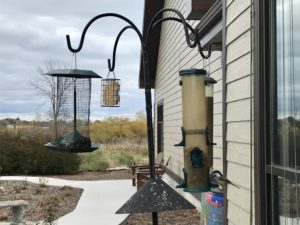Location is one of the first things to consider when setting up a bird feeder. A shepherd’s hook or a post driven into the ground works well for hanging multiple feeders and should be installed before the ground freezes. The post or hook should be placed closer than three feet or farther than 30 feet from windows. The area between is considered the strike zone and songbirds are more likely to fly into the window and become injured or even die. According to research, window strikes kill up to one billion birds each year, so feeder placement is critical to ensuring the safety of our feathered friends.
An ideal location will also have a nearby shrub or tree where birds can find cover. Many birds grab a seed from the feeder, then zip  off to a safe place to eat it.
off to a safe place to eat it.
There are many types of seeds and mixes available, but black oil sunflower seed is an excellent choice because it’s affordable, high in fat and attracts a wide variety of birds. This can be offered in a basic platform feeder or in a hanging feeder. Black oil sunflower seeds can also be scattered on the ground for birds such as juncos, white-throated sparrows and doves, which prefer to dine there. Its also good to scatter a little millet mix or cracked corn mix for these ground feeders.
If you’d like to attract goldfinches, pine siskins and other finches, you’ll want to feed Nyjer or thistle seed. These seeds are quite small, so it’s important to have a feeder made for this type of seed. Nyger seed can be prone to spoil, so if birds don’t eat it, discard it and buy a fresh bag.
Now that the weather is cooler, suet is something you may consider offering at your feeding station. Suet will attract woodpeckers, nuthatches and chickadees. You can purchase suet at local stores or even make your own.
Finally, having a water source near the feeder is an excellent way to attract birds. Keep in mind, they only need an inch or two for bathing and drinking. If ice forms, break it up so birds can access the water or purchase a temperature-controlled water heater for the bird bath.
It’s important to keep your feeding station tidy. Rake up empty shells under the feeder when possible and regularly clean the feeders to reduce the spread of diseases. Soak the feeders or scrub with a dilute bleach solution, rinse thoroughly and let them dry completely before adding seed.
Knowing where to place your feeder and what to feed will increase the variety of birds that visit your yard. Happy birdwatching!
